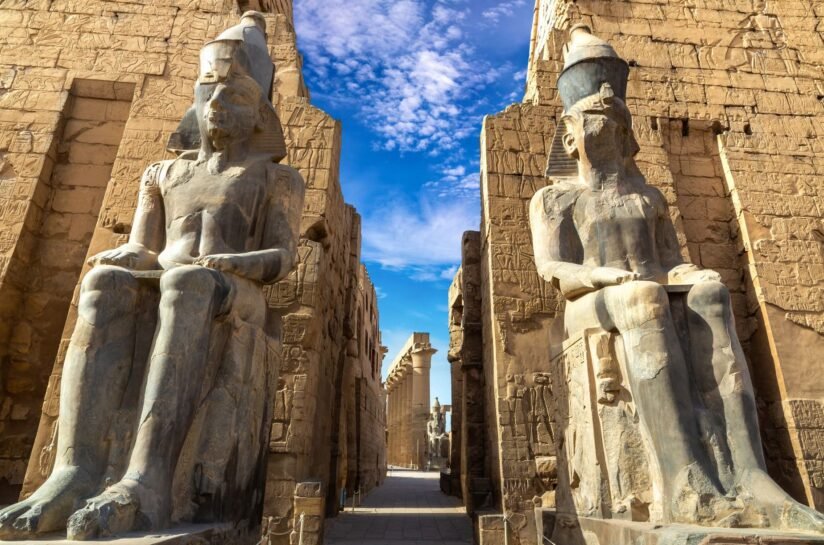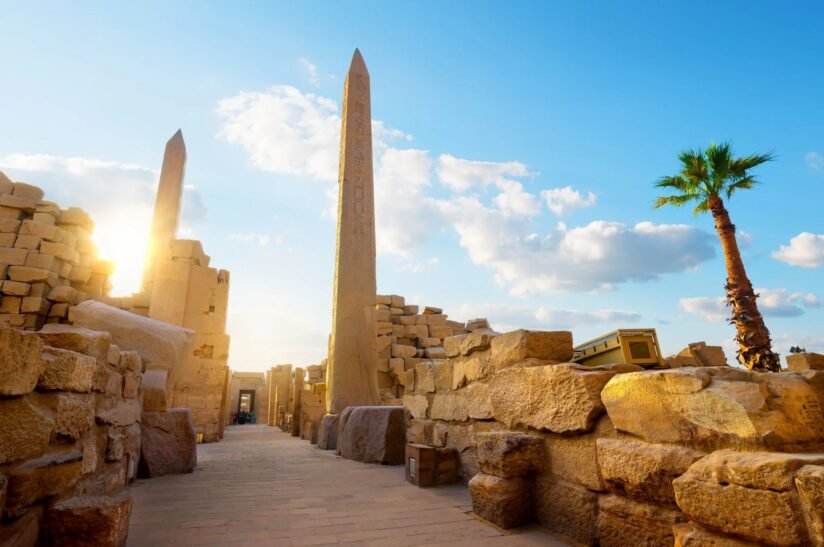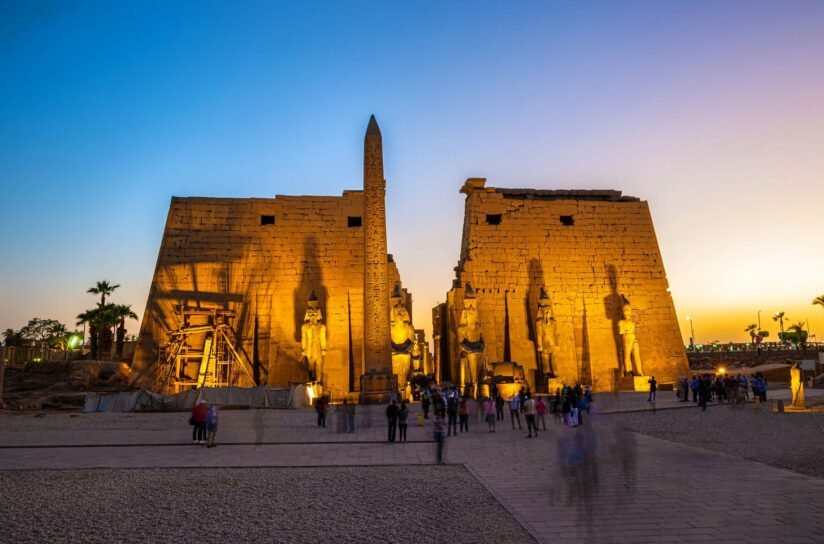Planning a visit to Luxor Temple in Egypt is like stepping into a living museum of ancient wonders. Located on the east bank of the Nile in the heart of modern Luxor, this iconic site was once the spiritual center of Thebes, ancient Egypt’s capital. It’s not just a collection of ruins—it’s a powerful reminder of over 3,000 years of uninterrupted worship, politics, and architecture.
This Luxor Temple, Egypt travel guide will walk you through everything you need to know to make your visit meaningful, easy, and memorable. We’ll cover ticket prices, how to get there from Cairo, what to see inside the temple, tour suggestions, and when to go. Whether you’re a solo traveler, a couple, or part of a family tour, this article is your one-stop resource for planning your Luxor adventure.
Where to Stay Near Luxor Temple
Finding the right place to stay is essential when visiting Luxor. The city offers various hotels catering to different budgets and preferences. Here are the best picks within easy reach of Luxor Temple:
Top Hotel Recommendations:
- Sofitel Winter Palace: A historic luxury hotel with past guests including Agatha Christie and Winston Churchill. Lush gardens and Nile views complete the charm.
- Steigenberger Resort Achti: Riverside location with resort-style amenities and multiple pools. Great for families and more extended stays.
- Pyramisa Isis Hotel: A comfortable, mid-range hotel near the Nile promenade and within walking distance to the temple.
- Al Moudira Hotel: Located on the west bank, this boutique hotel offers an artistic retreat near the Valley of the Kings.
All these hotels offer easy access to the east bank, where Luxor Temple is located. Some even provide shuttle services to significant sites, including Karnak and the Valley of the Kings.
Bonus Tip: Choose a hotel with a view of the Nile or a temple for stunning sunset moments right from your balcony.

History of Luxor Temple
Understanding the history of Luxor Temple adds rich context to your visit. This temple isn’t just another ancient ruin—it’s a timeline carved in stone.
Construction & Ancient Use:
Built around 1400 BC, the temple was primarily constructed under Amenhotep III, with additions by Ramesses II. Later enhancements came from Tutankhamun, Alexander the Great, and the Romans.
Unlike other temples dedicated to gods, Luxor Temple was dedicated to the “Royal Ka,” a spiritual aspect of kingship. It played a central role in the Opet Festival, where statues of the gods Amun, Mut, and Khonsu were paraded from Karnak to Luxor.
Roman & Christian Era:
The Romans repurposed parts of the temple into a fortress and later a Christian church. Frescoes from this period are still visible inside some chambers.
Islamic Period & Rediscovery:
The Mosque of Abu Haggag, still active today, was built directly atop the temple. Over centuries, the temple was buried under silt and sand, with homes and buildings constructed on top.
Excavations began in 1885, led by French Egyptologists, and the site has since been partially restored. The recent reopening of the Avenue of Sphinxes in 2021 reconnected it physically and symbolically to Karnak Temple.
Modern-Day Significance:
Today, it’s part of a UNESCO World Heritage Site and still plays a ceremonial role during cultural festivals, especially the Opet Festival reenactments.

Visiting Luxor Temple: General Information
Who Should Visit:
Luxor Temple is ideal whether you’re a history buff, spiritual seeker, or curious about ancient architecture. It’s suitable for solo travelers, couples, and families alike.
Visit Duration:
Plan to explore the temple thoroughly for about 60 to 90 minutes, though photography lovers may want longer.
Accessibility:
- It is wheelchair-friendly for the most part.
- Expect some uneven terrain, especially around the obelisks and inner courtyards.
Cultural Etiquette:
Due to the presence of the Abu Haggag Mosque within the complex, modest dress is advised. Avoid sleeveless tops and short shorts to show cultural respect.
Best Time to Visit Luxor Temple
Timing your visit can make a huge difference in your experience.
Time of Day:
- Morning: Great for cooler temperatures and fewer crowds.
- Sunset: Golden-hour lighting turns sandstone walls into glowing amber.
- Night: Magical illumination transforms the entire site. Don’t miss the Light & Sound Show, which requires a separate ticket.
Best Season:
The best season to visit is from October to March, when temperatures are pleasant and more suitable for walking tours. Summer can be extremely hot, often over 40°C (104°F).

Best Things to See & Do
Inside Luxor Temple, every corner reveals a new surprise. Here’s what to focus on during your visit:
Avenue of Sphinxes Tour:
- Recently restored, this 3-kilometer path connects Luxor and Karnak Temples.
- Can be walked or explored with a guided Avenue of Sphinxes tour.
- Originally lined with over 1,300 sphinx statues.
Architectural Highlights:
- Massive Pylons: Flanked by two colossal seated statues of Ramesses II.
- Great Court of Ramesses II: Features an impressive colonnade and floral column capitals.
- Sanctuary of the Barque: Houses a granite shrine, once used to store ceremonial boats.
- Obelisk: One of two original obelisks remains; the other is now in Place de la Concorde in Paris.
- Mosque of Abu Haggag: A unique example of a mosque built directly within an ancient temple is still active today.
Photography Tip: The inner sanctum and obelisk area offer fantastic photo opportunities, especially during golden hour or at night.
Luxor Temple Ticket Prices & Hours
Operating Hours:
Open daily from 6 AM to 10 PM.
Ticket Prices:
| Category | Price (EGP) | Approx. USD |
|---|---|---|
| Adults | 160 EGP | ~$5.50 |
| Students (with ID) | 80 EGP | ~$2.75 |
- Photography: No extra charge for phones or personal cameras.
- Luxor Pass: Consider buying this if you’re visiting multiple sites. It gives access to all the east and west bank attractions.
Pro Tip: Tickets for the Light & Sound Show are sold separately and usually start around 200 EGP.
How to Get to Luxor Temple from Cairo
How do you reach Luxor Temple if you’re starting from Cairo? Here are your options:
From Cairo:
- Flight: 1-hour direct flight (~ USD 90). Fastest option.
- Sleeper Train: Comfortable overnight journey (~ USD 80).
- Day Train: Budget-friendly (~ USD 10), but long (9–10 hours).
Local Access:
- Luxor Temple is in the city center on the east bank of the Nile.
- The ferry from the west bank drops you near the entrance.
- Most hotels nearby are walkable to the temple.
Local Tip: Expect street vendors and horse-drawn carriages (calèches) around the entrance. Bargain politely and walk away if not interested.
Best Luxor Temple Tours
A guided tour can enrich your visit and save you from logistical headaches.
Why Book a Tour?
- Expert guides offer profound insights into ancient myths, art, and architecture.
- Skip long lines and avoid misinterpretations of symbols and ruins.
Recommended Itinerary:
- Morning pickup from the hotel or cruise.
- Visit Karnak Temple, then walk or drive the Avenue of Sphinxes.
- End at Luxor Temple, ideally around sunset.
- Optional add-on: Valley of the Kings or Colossi of Memnon.
Bonus Tip: Choose a tour that includes the night show for a truly magical experience.
Wrap-Up
Luxor Temple is more than a historical site—it’s a journey through millennia of religion, royalty, and architectural grandeur. Past and present meet beautifully from the imposing statues of Ramesses II to the active mosque of Abu Haggag.
Whether you’re exploring the Avenue of Sphinxes tour, watching the temple glow under golden sunset light, or standing inside the same sanctuary visited by Pharaohs, this experience will leave a lifelong impression.
Pack modest clothing, bring a camera, and don’t forget to take your time soaking in the history. With this complete Luxor Temple Egypt travel guide, you’re fully equipped for a journey into one of the most enchanting places in Egypt.
FAQ’s
- Is Luxor Temple safe to visit?
Yes, it’s very safe. Luxor is tourist-friendly and well-patrolled. Stick to public areas and licensed guides. - Can you visit Luxor Temple at night?
Yes. The temple is open until 10 PM and is beautifully lit. Consider booking the Light & Sound Show. - How long do I need to visit Luxor Temple?
Plan for about 60–90 minutes. Combine with nearby sites for a half-day tour. - Can you walk from Karnak to Luxor Temple?
Yes, the Avenue of Sphinxes is a 3 km walk between both temples. Flat terrain makes it easy. - Is the temple wheelchair accessible?
Mostly yes, though expect some uneven ground.
